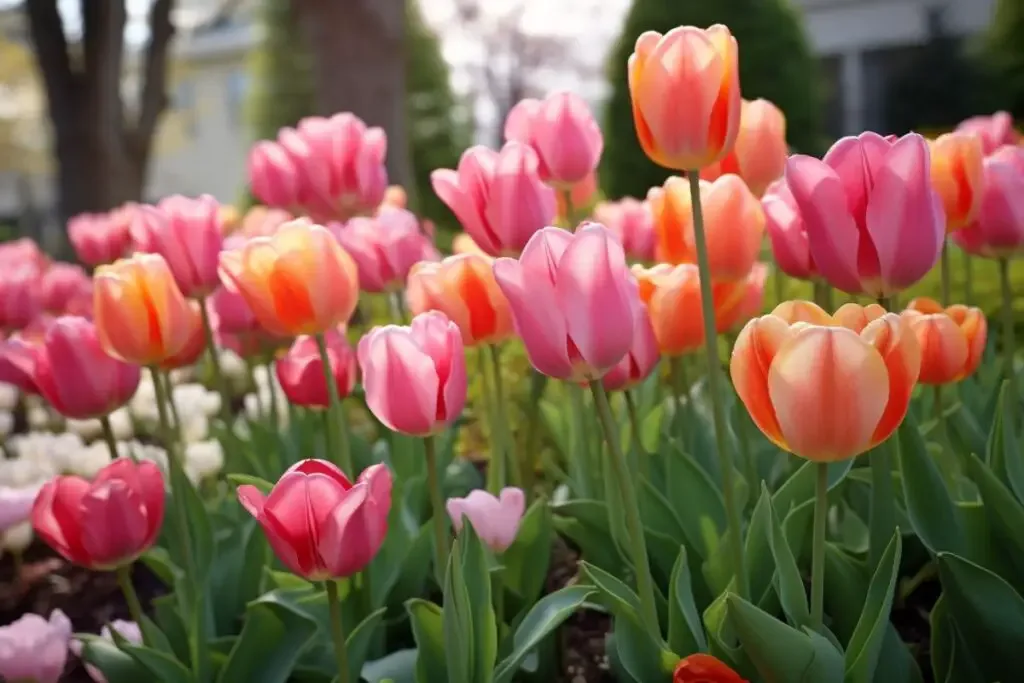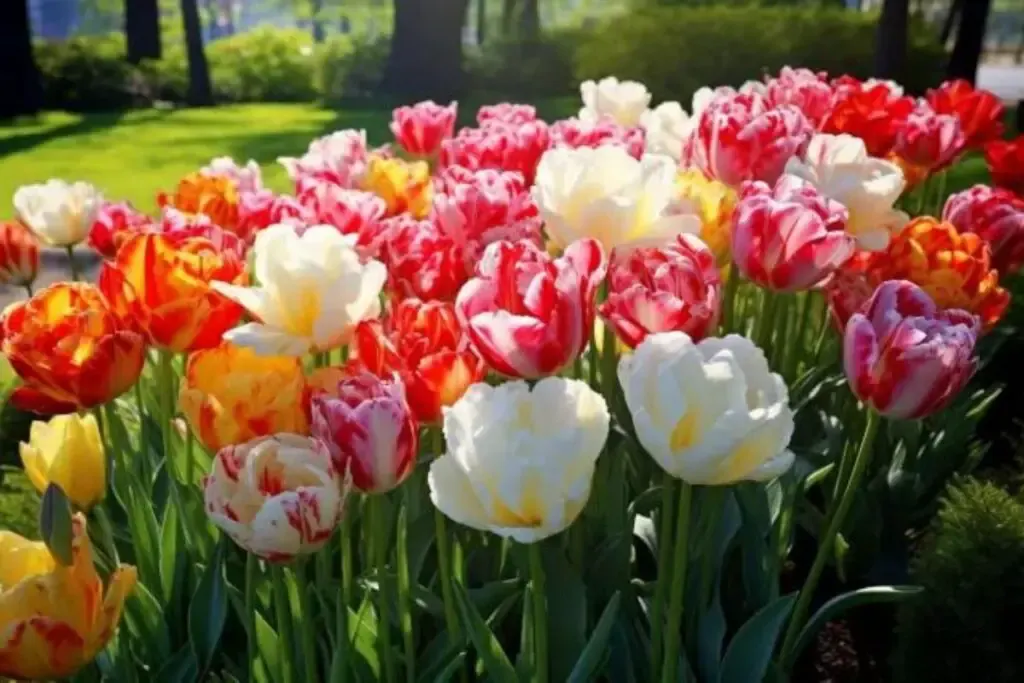Tulips are one of the most beloved and iconic spring flowers, known for their vibrant colors and elegant shape. If you’re looking to add a touch of beauty to your garden or brighten up your home, tulips are an excellent choice.
In this guide, we’ll explore the benefits of growing tulips and discuss some of my favorite tulip varieties to help you get started on your tulip-growing journey.
Benefits of Growing Tulips

Tulips offer a multitude of benefits that make them a favorite among gardeners. Here are three compelling reasons to consider planting tulips in your garden:
1. Stunning Spring Color Display
One of the primary reasons people love tulips is their breathtaking display of color in the spring. These flowers come in a wide range of hues, from brilliant reds and pinks to soft pastels and striking yellows. Planting tulips can transform your garden into a vibrant and cheerful oasis as winter transitions to spring.
2. Low Maintenance Beauty
Tulips are relatively easy to grow and maintain, making them an excellent choice for both experienced and novice gardeners. They thrive in well-drained soil and require minimal care once planted. With proper attention to watering and a sunny spot, you can enjoy their beauty year after year with minimal effort.
3. Versatile Garden Companions
Tulips are incredibly versatile and can be used in various garden settings. They look fantastic in flowerbeds, borders, and containers.
You can mix different tulip varieties to create stunning combinations of colors and shapes that suit your personal style. Additionally, they work well as cut flowers, allowing you to bring their beauty indoors for floral arrangements.
My Favorite Tulips: Varieties
When it comes to tulips, there is a vast array of varieties to choose from, each with its unique charm.
Here are three of my personal favorite tulip varieties that I believe every tulip enthusiast should consider:
1. Darwin Hybrid Tulips

Darwin Hybrid Tulips are renowned for their large, vibrant blooms and sturdy stems. They come in a range of colors, including red, pink, and orange, and can reach heights of up to two feet. These tulips make a bold statement in the garden and are perfect for creating eye-catching displays.
2. Triumph Tulips

Triumph Tulips are known for their classic tulip shape and rich, intense colors. They are among the earliest tulips to bloom in the spring, adding a burst of color to your garden when you need it most. With a wide variety of hues available, you can find Triumph Tulips to complement any garden theme.
3. Parrot Tulips

Parrot Tulips are named for their uniquely fringed and ruffled petals, which resemble the feathers of a parrot. These whimsical tulips come in a variety of colors, including red, orange, and yellow. Their playful appearance adds a touch of fun and intrigue to any garden.
Tulip Care
Now that you’ve decided to grow tulips and have learned about their benefits and some favorite varieties, it’s essential to understand how to care for these lovely spring flowers. Proper care ensures that your tulips thrive and continue to bring joy to your garden year after year.
Planting

Planting tulips correctly is the first step toward a successful tulip garden. Follow these steps for optimal results:
- Timing: Plant tulip bulbs in the fall, ideally about 6 to 8 weeks before the first hard frost in your area. This timing allows the bulbs to establish strong roots before winter sets in.
- Depth: Dig a hole that’s about 3 times deeper than the height of the bulb. For most tulip varieties, this means planting them about 6 to 8 inches deep.
- Spacing: Space the bulbs about 4 to 6 inches apart to allow them room to grow and spread.
- Orientation: Plant the bulbs with the pointed end facing upward. This is where the stem and leaves will emerge.
- Soil Preparation: Ensure the soil is well-draining and amended with organic matter, such as compost, to provide nutrients for healthy growth.
Light
Tulips thrive in full sun to partial shade. Here’s what you need to know about providing the right amount of light:
- Full Sun: Tulips perform best when they receive at least 6 to 8 hours of direct sunlight per day. In areas with hot summers, they can benefit from some afternoon shade.
- Partial Shade: If you’re in a region with scorching summers, planting tulips where they receive morning sun and afternoon shade can help prevent the bulbs from overheating.
Soil
Tulips are not particularly picky about soil, but they do have some preferences:
- Well-Draining: The soil should be well-draining to prevent waterlogged roots, which can lead to bulb rot. Sandy or loamy soils work well.
- pH Level: Tulips prefer slightly acidic to neutral soil with a pH range of 6.0 to 7.0. You can adjust the pH if necessary with appropriate soil amendments.
Water
Proper watering is crucial for tulip care:
- Moderate Moisture: Water your tulips when the soil is dry to the touch, but avoid overwatering. They prefer moderate moisture levels and can rot if the soil is consistently soggy.
- Rainfall: Be mindful of natural rainfall. If your region receives adequate rain, you may not need to water as frequently.
Temperature and Humidity
Tulips are generally hardy, but extreme temperatures and humidity levels can impact their performance:
- Winter Chill: Tulips require a period of cold dormancy in winter to bloom in the spring. Most varieties can tolerate cold winters, but you may need to mulch the bulbs to protect them in extremely cold climates.
- Humidity: High humidity can lead to fungal diseases, so good air circulation is essential. Avoid planting tulips in areas with poor air circulation.
Fertilizer
Feeding your tulips ensures they have the nutrients they need for healthy growth and vibrant blooms:
- Spring Feeding: Apply a balanced, slow-release fertilizer in the spring as the shoots emerge. Follow the package instructions for proper application rates.
- Avoid Overfeeding: Be cautious not to over-fertilize, as this can lead to excessive foliage growth at the expense of flowers.
Pruning
Pruning tulips may not be as extensive as with some other plants, but it’s still an essential part of tulip care. Here’s what you need to know about pruning your tulips:
- Deadheading: As the tulip blooms fade, it’s a good idea to deadhead them by removing the spent flowers. This prevents the plant from putting energy into seed production and encourages stronger bulb development for the next year.
- Leaving Foliage: While it’s tempting to cut back tulip foliage once the flowers have withered, it’s essential to let the leaves turn yellow and die back naturally. During this time, the plant is replenishing energy reserves in the bulb for the following year’s growth. Once the leaves have completely yellowed, you can trim them back.
Propagating
Propagating tulips is typically done by dividing bulbs, as growing them from seed can take several years to produce flowering plants. Here’s how to propagate tulips by dividing bulbs:
- Dividing Bulbs: After several years of growth, tulip bulbs can become overcrowded and produce smaller, less vigorous blooms. To maintain healthy plants, dig up the bulbs in late spring or early summer once the foliage has withered. Carefully separate the bulbs, discard any damaged or diseased ones, and replant them at the appropriate depth.
How to Grow Tulips From Seed
Growing tulips from seed can be a rewarding but time-consuming process. Here’s a brief overview of how to grow tulips from seed:
- Collecting Seeds: After the tulip flowers have faded, allow the seed pods to develop and mature. Collect the seeds once the pods start to split open and reveal the seeds inside.
- Seed Stratification: Tulip seeds require a period of cold stratification to mimic winter conditions. Place the seeds in a plastic bag with damp sand or peat moss and refrigerate them for about 8-12 weeks.
- Sowing: Plant the stratified seeds in containers or seed trays filled with well-draining soil in late winter or early spring. Keep them indoors until the threat of frost has passed.
- Transplanting: Once the seedlings have grown large enough and the weather is suitable, transplant them into your garden.
- Patience: Growing tulips from seed can take several years before you see the first blooms, so patience is key.
Growing in Pots

If you have limited garden space or want to enjoy tulips on a patio or balcony, growing them in pots is an excellent option. Here’s how to do it:
- Container Selection: Choose large, well-draining containers with drainage holes to prevent waterlogged soil.
- Potting Mix: Use a high-quality potting mix designed for bulbs or flowers. Ensure it’s well-draining.
- Planting Depth: Plant tulip bulbs in pots at the recommended depth, usually about 6 to 8 inches deep.
- Watering: Keep the soil consistently moist but not soggy. Potted tulips may need more frequent watering than those in the ground.
- Sunlight: Place the pots in a location that receives at least 6 hours of sunlight per day.
- Fertilizing: Use a balanced liquid fertilizer according to the package instructions to provide nutrients to your potted tulips.
Overwintering
Overwintering tulip bulbs ensures they survive the colder months and bloom again next spring:
- Mulching: In colder climates, add a layer of mulch over the soil in late fall to insulate the bulbs and protect them from extreme cold.
- Lifting Bulbs: In regions with harsh winters, consider lifting the bulbs after the foliage has withered, storing them in a cool, dry place, and replanting them in the fall.
Transplanting
Transplanting tulips can be necessary if they’ve become overcrowded or if you want to move them to a different location. Here’s how to transplant tulips:
- Timing: Transplant tulips in late spring or early summer when the foliage has withered.
- Digging: Carefully dig up the bulbs, taking care not to damage them.
- Replanting: Plant the bulbs at the appropriate depth in the new location with well-draining soil.
Common Pests & Diseases
Tulips can be susceptible to a few common pests and diseases:
- Aphids: Keep an eye out for aphids, which can infest tulip plants. Use insecticidal soap or neem oil to treat infestations.
- Tulip Fire: Tulip fire is a fungal disease that causes red spots on the leaves. Remove affected leaves and destroy them to prevent the spread of the disease.
- Botrytis Blight: Botrytis blight is another fungal disease that can affect tulips. Ensure good air circulation and avoid overhead watering to prevent it.
With proper care, pruning, and attention to potential issues, you can enjoy healthy, vibrant tulips in your garden year after year.
Happy gardening!
